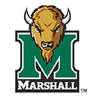|
|
HOME ~ College Football History |
Why
The Thundering Herd?
The Thundering Herd is American folklore ... as old as the buffalo that
roam the western plains. The Herd once provided nearly every substance
needed for human survival, including food, clothing, tools and weapons.
The
 Herd still provides Marshall University's athletic teams with their
nickname. Herd still provides Marshall University's athletic teams with their
nickname.
"Thundering Herd" has long been recognized by sports enthusiasts as one
of the great, distinctive nicknames in college athletics. But on several
occasions throughout Marshall's history other nicknames have been
suggested and, on occasion, been hung on the school.
The first nickname of record is Indians, a moniker bestowed upon the
pre-1900 athletic teams. By about 1910, sparked by the color of team
uniforms, Big Green began to be used in reference to Marshall athletics.
Criticized by some from its inception as being boring, Big Green was
soon ripe for replacement.
When Huntington Herald-Dispatch sportswriter Duke Ridgley referred to a
late-1920s squad as a Thundering Herd, after a then-current movie based
on the 1925 Zane Gray novel of the same name, it caught on quickly. Both
Thundering Herd and Big Green have been used in reference to Marshall
ever since.
It didn't take long, however, for Thundering Herd to draw criticism as
well. Some folks thought it inappropriate since it came with
connotations of the western plains and didn't represent West Virginia or
founding father John Marshall. One suggested nickname, which never
caught on, would have honored John Marshall by calling the school's
teams the Judges.
Huntington Advertiser sportswriter Dug Freutel in 1933 started referring
to Marshall teams as the Boogercats (referring to Scotland's Bogie Cats,
a "fleet, elusive, courageous" animal) and some other scribes followed
in using that nickname. Freutel complained that Thundering Herd made one
think of "cows stampeding down a country road," but many people thought
Boogercats stirred up worse images than that.
The Boogercat controversy sparked the Marshall alumni association to
hold a special meeting, in which a vote was taken to refer to the school
teams as the Thundering Herd for the time being - but that a study
should be undertaken to find a mascot that had a connection with the
school or West Virginia.
Despite Freutel's attempts to keep Boogercat alive for the next couple
of years, Thundering Herd and Big Green remained the commonly used
nicknames. In 1958 the Marshall student body, without input from the
faculty, administration or alumni, decided that two nicknames wouldn't
do and held a vote to settle the issue. Along with Thundering Herd and
Big Green, one group of students bought a turkey as a suggested mascot
and promoted the name Green Gobblers.
The students voted on Big Green as the nickname, but the media continued
to use Thundering Herd to refer to the teams.
In the fall of 1964 Marshall president Stewart Smith appointed a
faculty-student committee to suggest a more permanent nickname, feeling
that Big Green denoted no action and was not appropriately symbolic. The
nine-member committee narrowed its field to Big Green, Thundering Herd
and Rams, which had been suggested by Huntington businessman Leonard
Samworth, a past president of the alumni association.
On January 5, 1965, over 85 percent of the Marshall students picked
Thundering Herd above the others and chose the buffalo as the official
mascot and green and white as the official school colors. The athletic
fundraising organization took on the name Big Green, and Rams was left
by the wayside along with Judges, Indians and, of course, Boogercats.
Fight Song
Sons of Marshall
by Ralph A. Williams (1936)
We are the Sons of Marshall
Sons of the great John Marshall
Year after year we go to Marshall U.,
cheering for our team and gaining knowledge, too.
Proudly we wear our colors, love and loyalty we share.
Sure from far and near, you always hear
the wearing of the green,
but it is the green and white of Marshall U!
Alma Mater
by Dr. C.E. Haworth and James R. Haworth (1935)
Marshall gracious Alma Mater, we thy name revere;
may each noble son and daughter cherish thine honor dear.
May thy lamp be ever bright, guiding us to truth and light,
as a beacon o'er dark waters. This is for thee our prayer.
May the years be kind to Marshall, may she grow in fame.
May her children fail her never, true to her beacon flame.
May her spirit, brave and strong, honor right and conquer wrong;
this the burden of our song, ever her truth proclaim.
Home Page 
|

 Herd still provides Marshall University's athletic teams with their
nickname.
Herd still provides Marshall University's athletic teams with their
nickname.